|
Two April Troopships Going To New York
I-B personnel leaving for the United States in April will see the Statue of Liberty rather than the Golden Gate bridge as one of the first familiar Stateside sights, it was learned this week when Theater headquarters announced a revised shipping schedule for next month. Under the new plan, two "General" type transports will travel to the U.S. via the Suez Canal and the Mediterranean, docking in New York. These two ships will be the first from the I-B to dock on the East Coast in several months. The General Sturgis will sail from Calcutta on April 12, replacing General Heintzelman which was scheduled to depart Calcutta for San Francisco on April 16. The General Hersey will sail fro New York from Calcutta on April 21 in place of the General Scott which was originally slated to leave Calcutta for Seattle on April 27. Spokesmen said the switch in ships will not affect the number of personnel moved homeward during the month and added that with the sailing of the General Hersey, all personnel eligible to return to the United States under the April 30 criteria will have been started toward home. The two new April ships average about 3,200 spaces for personnel, it was said. March shipping plans were unchanged this week. The Marine Jumper is scheduled to leave Calcutta about March 22 for Seattle, followed by the Marine Cardinal which will sail on March 24 for San Francisco.
|
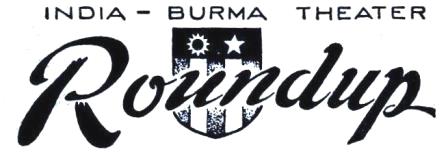
|
Legions Promenade Down
Avenues - Into History
By SGT. CHARLES W. KELLOGG Roundup Editor
NEW DELHI - Down the broad avenues of this Empire City they came last Thursday afternoon - the men and the women and the animals who know what war is because they helped to win one not so long ago. They marched through the lifted dust and the slanting afternoon sunlight and the blue smoke from the exhausts of mechanized might and those who saw them march will never forget.
By the great arch they came and when they passed the reviewing stand their leaders saluted and the crowds in the stands cheered. It was a cry of praise and pride - yes - and of something else - because there were invisible gaps in the even ranks - gaps which never can be filled - gaps which were left open by those who didn't march because they weren't around to march nor will they ever march again.
They swung on down the way behind the rumbling roar of the tanks and the trucks and the armor which men and women in America and Canada and Britain worked hard to build. Hidden beneath the somber hues of war paint were the names Americans know so well - Mack and Studebaker, Federal and Dodge, Ford, Chevy and GMC. Yes, there was quite a hunk of the U.S.A. represented in that procession.
OLD GLORY
Behind the armor came the troops and Old Glory was in the lead. The flag of the United States swayed in the breeze of India and 200-odd men from Indiana and Ohio, Maine and California and Minnesota and Texas and a lot of other states marched with their flag down a street on the other side of the world from home.
Then came the Africans - tall, lean men from Nepal and their cousins from the Gold Coast and those from the Nile delta. Behind them came the little, fierce men of Burma who prowled through the tangled jungles of their native hills and brought swift, silent and horrible judgment to the invader.
The Indians followed - men and boys from every state and section of this crowded land. The mountain men with their mules and their howitzers, the desert men high on their swaying camels, the men from Madras and Bengal and the Punjab, the smaller men from the Tibetan border and the barefooted Naga tribesmen in their ceremonial and brilliant garb - they stood for a vast land and a proud people.
At the end, for a little while, the women marched - the girls of the WAAF and the girls of the WAC (I) and the ATS and the WRIN and the nurses. They marched as they had done everything else they had to do in the grim days when the shells burst and the torpedoes struck - willingly and proudly.
So, along the broad avenues and down through the circling streets of the new city they went - on into history. Much of the time there was no noise but the noise of their passing - the shrill scream of the pipes and the rumble of armor and the steady tramp of marching men. Here and there a dog barked and a mule brayed and a baby cried. Here people shouted. At other places they clapped - but for long stretches the crowds watched, simply made silent by their own thoughts and emotions.
FOND MEMORY
It was the strength of a mighty war machine which passed in review here that afternoon last week. There were heroes from many lands - some decorated, but many more honored only - yet adequately - by the uniform they wore and the banners they followed. It may be that decades will pass before another line such as this passes by Memorial Arch. But the memory of the men and the women and the machines who marched under it on an afternoon in March, 1946, will serve until that day comes.
Americans Join In New Delhi Victory Week
NEW DELHI - India's capital took on a holiday air last week as a full program of events filled the city with visitors for the official local celebration of victory by the Allies over Germany and Japan. It was Delhi Victory Week.
Highlight of the week was the parade on Thursday, in which 10,000 men and women, horses, mules, camels, mechanized equipment, bands and airplanes took part. The Viceroy of India, Lord Wavell; the Supreme Commander of Southeast Asia, Lord Louis Mountbatten; the Commander-in-Chief in India, Sir Claude Auchinleck; and the U.S. Acting India-Burma Theater Commander, Maj. Gen. Vernon Evans, were on hand to witness the event.
First in line were units of the Armored Corps. Artillery, and Engineers of the British and Indian Armies with their equipment. Then came massed pipe bands and massed flags of formations.
YANKS HEAD MARCHERS
A crack detachment of 200 American troops, led by Capt. Donald McCullough, headed the marching columns.
Then came detachments from Nepal, West Africa, East Africa, Burma, the Royal Indian Navy, the Royal Indian Artillery, the Royal Indian Engineers, British Infantry, Indian State Force Infantry, Special Detachments, Royal Indian Army Service Corps, Indian Army Medical Corps, Indian Army Veterinary Corps, Indian Army Ordnance Corps, Army Remount Department, Indian Pioneer Corps, Indian Army Corps of Clerks, the Royal Air Force, and Royal Indian Air Force.
Next in line were massed provincial banners, Boys Detachments from most of the units of the Indian Army, Boys Detachments representing Indian State Forces, a Boys Detachment from the Royal Indian Army Service Corps, Women's Services, and Delhi Police Band and Delhi Police Department.
The fly-past by planes of the Royal Air Force and Royal Indian Air Force concluded the parade. They included three Cornells, five Harvards, three Dakotas, six Hurricanes, 36 Spitfires and six Lancasters.
EVANS LAUDS MEN
General Evans said afterwards: "The I-B Theater Detachment in the parade did a fine job. They looked and acted like American soldiers. The rest of us Americans appreciate it."
The week's events got underway on Monday morning with a "Remembrance" Ceremony at Memorial Arch. Two thousand troops, representing all arms of the Indian, Nepalese and Burma Services, joined in exercises dedicated to those who lost their lives in World War II.
A military "tatoo" was given on Monday evening at Irwin Stadium and repeated on Wednesday, Friday and Saturday, in which various exhibitions of marching, bagpipe playing and mechanized equipment were given, and the sky was lit brightly with fireworks.
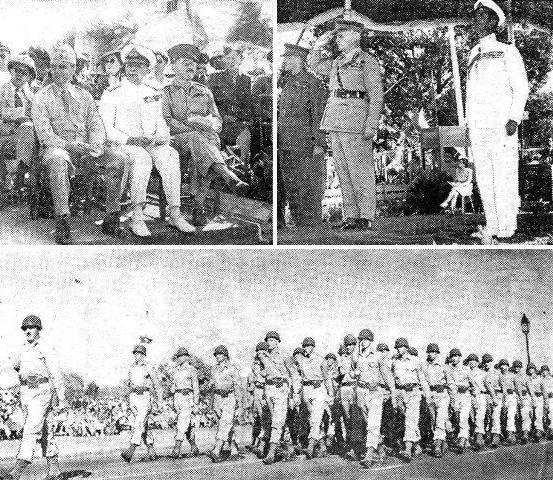 (Top left) Maj. Gen Vernon Evans (left), Acting I-B Theater Commander; Vice-Adm. Sir Arthur Palliser, C-in-C Designate
of the British Eastern Fleet; and Lt. Gen. C. M. P. Durnford, Quartermaster of the Indian Army, witness the parade.
(Top right) Gen Sir Claude Auchinleck (left), C-in-C of the Indian Army; the Viceroy, Lord Wavell; and Adm. Lord Louis
Mountbatten, Supreme Allied Commander, Southeast Asia, take the salute on the march past. (Below) The American detachment,
largest single unit in the parade.
(Top left) Maj. Gen Vernon Evans (left), Acting I-B Theater Commander; Vice-Adm. Sir Arthur Palliser, C-in-C Designate
of the British Eastern Fleet; and Lt. Gen. C. M. P. Durnford, Quartermaster of the Indian Army, witness the parade.
(Top right) Gen Sir Claude Auchinleck (left), C-in-C of the Indian Army; the Viceroy, Lord Wavell; and Adm. Lord Louis
Mountbatten, Supreme Allied Commander, Southeast Asia, take the salute on the march past. (Below) The American detachment,
largest single unit in the parade.
|
I-B BEER PRICE CUT
With the advent of summer heat and thirsty throats of Theater G.I.'s, the price of beer has been reduced from six to five rupees per case, the Army Exchange Service proudly announced this week.
But the saving is emphasized on the purse, not the thirst as the usual two cases per man per month still prevails.
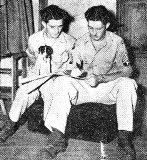 T/4 Daniel and T/4 Wendell Winsen.
T/4 Daniel and T/4 Wendell Winsen.
|
It took a letter from Gen. Hershey's office to get twin brothers T/4 Daniel and Wendell Winsen together in the Army, but now that the time is near to go home, Wendell says, "I'm not waiting for anyone - first come, first served."
The Sgts. Winsen are both Detroit boys now at Maidan Camp in Calcutta as supply and PX wallahs. Which does which is too complicated a question to answer. Wendell was inducted three months before Daniel. After carrying a request on up through channels, Gen. Hershey's office got them together at Camp Iuna, New Mexico, in August 1945.
Together they have stayed since - at Kunming, Kanchrapara, Camp Tollygunge, Camp Tagore and now Camp Maidan.
They've had the usual fun of answering roll call for each other. And of course, with their present jobs neither ever suffers from want of clothing or PX supplies.
'LAST ROUNDUP' COMES FOR THEATER ANIMALS
 One of the main functions of Remount in the I-B was the shipment of animals to the forward areas. In the top photo members of the 2nd Veterinary Company lead Missouri-bred mules into cars at Burgapore; below are shown typical animals handled by Remount - at left an Australian-bred horse and at right an American mule.
One of the main functions of Remount in the I-B was the shipment of animals to the forward areas. In the top photo members of the 2nd Veterinary Company lead Missouri-bred mules into cars at Burgapore; below are shown typical animals handled by Remount - at left an Australian-bred horse and at right an American mule.
|
Horses and Mules Played
Key Role In Combat Action
By SGT. WARREN UNNA Roundup Staff Writer
As it must even for the beast of burden, the last roundup has come for the I-B's 1,000-odd remaining horses and mules, the final lot when the 253rd Quartermaster squadron last month closed the corral gates at its remount station in Barapani, Assam.
For the veterans of practically every battle in the retaking of Burma, the parting with the U.S. Army was a quiet, business-like transaction. To buyers would go 873 of the animals, some of which were to be used by the British for breeding purposes; another 86, just discharged from the veterinary hospital, were mosied along with them; but 57 horses and four mules had come the last mile; they had to be shot because they suffered from chronic and incurable diseases.
There are still 38 horses being used by the Base Section Special Services' Riding Academy in Calcutta and 306 mules are being fed by the Quartermaster Section until the new Indian owner takes over, but Army trusteeship of both of these is scheduled to end this month.
Since its inception in the spring of 1944, the I-B Remount Service has handled some 18,000 horses and mules, supplying both Chinese and U.S. combat forces with transportation through the dense jungle growth of Burma. And not only were U.S. troops part of the Q.M. Remount Service, but Indian Army men and civilian horse handlers, working on a "lend-lease" basis, had their part as well.
FIRST DEPOT
The I-B's first remount depot was in operation between March and December 1944, at Ramgarh where a few animals were furnished the Chinese forces in training there. Here the 475th and 699th Remount Troops leisurely worked with the Indian syces (grooms) on a nearly peace-time basis, for nobody was interested in pack animals at that early point of the Burma campaign.
Then the war for the recapture of North and Central Burma began in earnest and radio messages started flashing from New Delhi to Washington for horses and mules, and more of same.
From the stateside pack training centers at Camps Hale and Carson in the Colorado Rockies the animals were hustled down to the P.O.E. at New Orleans. Cargo transports were equipped with stalls and their decks with an extra good flush system, just in case. The transports traveled through the Panama Canal and up past Guadalcanal and Australia where they piled on some 4,000 more horses and mules. Then they sailed to India.
The trips were rough, the waters infested with enemy subs, but that didn't quite explain the legend of the animal transport at the mouth of the Hooghly which couldn't bring itself to following the pilot boat for two whole days; its cargo of animals, humans and beer having become too thoroughly assimilated.
When they arrived at Calcutta, the animals were corralled through the I-B's equine pipeline; the Remount Service's three major depots and three sub-depots, stretching from the port itself to the front lines.
ONTO BOX CARS
Animals arriving at Calcutta were hustled out to the Alipore remount sub-depot where, as soon as they had been toned up from the boat ride, they were reloaded in box cars for the Pandu sub-depot in Assam. At Pandu, in the Khasi Hills, horses and mules got out of the box cars and into "eight-man" trailers for the ride to the first major remount depot at Barapani.
Here on the south bank of the Brahmaputra River, within shouting distance of Assam's capital of Shillong, men of the 475th and 699th Remount Troops trained for pack carrying, conditioned and shod all animals for combat. Since a mule wears out a pair of shoes every six weeks, the Barapani bootery was kept quite busy. The animals also went through a three-week quarantine period here and had their manes roached and their feet trimmed.
After the stay at Barapani the horses and mules were reloaded onto trailers back to Pandu where they were shipped by rail from the Pangtong remount depot to the 15-mile point on the Stilwell Road, right outside of Ledo. At Ledo, the 698th Remount Troop, the 1st Veterinary Detachment, four Indian remount units and some British officers provided the reception link between the rear area and the front lines.
Ledo was the first real stop-over the animals had to rest after the long journey and to put on flesh for the work ahead. The depot was a clearing in the jungle with bamboo stables suitable for keeping 1,000 animals at a time.
From Ledo the animals were marched, trucked and carried by rail through Shingbwiyang, Warazup and Mogaung to the third major remount depot at Myitkyina - a distance of 260 miles stretched over a 23-day period. Indian syces led the animals on foot and GI's accompanied them on horseback, herding the more spirited animals back into the group.
At Myitkyina, animals were held for combat replacement and issued through the most forward sub-depot at Bhamo to the frontline units. Out of 200 horses and mules usually herded through each week, 16 were replacements.
18,000 ANIMALS
All in all, the I-B's Remount Service handled some 18,000 animals for the use of Chinese and U.S. fighting forces. This number does not include the animals which had been recaptured by the Chinese from the Japanese and used by them to augment their supply. The British Remount Directorate furnished 10,000 of the 18,000; 4,000 Missouri mules came directly from the states; and 4,000 horses and mules were relayed to the I-B from the Southwest Pacific.
Included in the British group were some Indian-bred tonga ponies and Indian burros. The American mules were found to be well-suited for the needs of the 612th and 613th Field Artillery Battalions and six Q.M. Pack Troops, and the Chinese used them extensively to carry large gun loads. The horses, however, did not work out as well; the mountainous terrain and jungle climate discouraging their work output.
There were quite a few casualties, for besides injuring themselves on the rocky and steep trails, the animals were exposed to the tropical and sub-tropical diseases of negana, surra and swamp fever. The Burma climate even provided host to an equine venereal disease, but since the Remount Service wasn't concerned with breeding, there was no need for V.D. poster on the walls of the 16th Vet Evacuation Hospital at Barapani.
When the Burma campaign was over and Merrill's Marauders and the Mars Brigade went their way and the Chinese returned to their own country, the Remount Service began sending its horses and mules on forward for use in what was to be the final show-down in China. Last June the first of the Mars mules were driven in a group of 900 from Lashio to Kunming, a walk of 2,300 miles!
Traveling 15 to 20 miles a day in grazing groups staggered at a few days interval, the GI mule "skinner" and the Chinese "mafu" followed the old stone caravan trail of Marco Polo and proceeded to the Stilwell Road. At times the going was so tough they had to cling to the tails of their mules to get up the steep ravines. Once they hit the Road, however, things became civilized and they even had mess trucks, both for the animals and the skinners. Some had an even easier time: they were "herded" over the Hump in planes.
4,000 ON V-J DAY
By V-J Day all but 4,000 of the 18,000 animals handled in the I-B had been either transferred to China or lost to disease and enemy action. The remount depots were consolidated and the horses and mules sold. Now that Barapani has closed all U.S. supervision has ceased.
To find a Missouri mule these days it's necessary to listen carefully for a Yankee bray along the cart paths of India or on the high, clear trails of Western China.
And then there are not a few of the Remount Service's faithful who just didn't get that far. They're dead and gone, fallen on the battle-lines where they sweated and lugged, getting the food and guns up to the front.
I-B FOOD RATIONS CUT TO EASE WORLD CRISIS
Food shortages are becoming critical throughout Europe, the Far East and Russia. Within the next few months, 100,000,000 Europeans will be down to a daily average of 1,500calories and some 140,000,000 will be down to 2,000 calories, according to the Allied Emergency Economic Committee for Europe.
The United Nations Relief and Rehabilitation Administration, taking an active role in the world food crisis, considers the "safe minimum" to be about 2,500 daily calories. Time reports the U.S. average is about 3,300 a day.
India's 6,000,000 long tons of grain deficit due to failure of the winter monsoons this year will have to be replenished from the outside. Australia is planning to send to India 1,000,000 tons of grain and the Government of India is cutting the daily ration from 16 to 12 ounces. Nevertheless, the Indian food situation will be critical and the food delegation for India is requesting 4,000,000 long tons of grain imports.
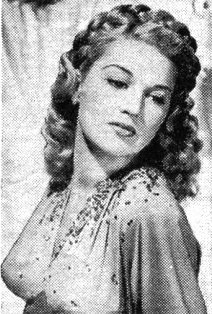 If Ann Sheridan and Alexis Smith, with their height could do it, why couldn't I, Joanie Fulton asked herself. She's
succeeded, despite her 5' 7½", in getting two featured movie roles already. Okay?
If Ann Sheridan and Alexis Smith, with their height could do it, why couldn't I, Joanie Fulton asked herself. She's
succeeded, despite her 5' 7½", in getting two featured movie roles already. Okay?
|
CUT IN THEATER
U.S. Army personnel in the India-Burma Theater are helping the food shortage in this area by a recent cut in ration allowances. The caloric content of the new ration allowance is now 3,641 per day which is in line with the new caloric values of the ration as prescribed by War Department directives in the aiding of the U.S. Food Conservation program, according to Theater Quartermaster. No pork, beef or citrus fruits were included in this ration cut.
All unit commanders within the I-B have been instructed by Theater headquarters to take every measure to eliminate any food wastage within their commands and to impress upon all military personnel the necessity for food conservation.
Already thousands of tons of food in the theater have been declared surplus and turned over to FLC for sale to UNRRA and the Government of India, the Quartermaster spokesman stated.
UNRRA has already purchased 16,664 long tons of meat components, 10-in-1 rations, evaporated milk, butter and other foodstuffs for $4,843,859, according to Mr. Edmond Williams, UNRRA representative in New Delhi. He said all but 82,550 pounds of this amount, which is going to Europe, will go to relieve the food shortage in China.
SALE TO INDIA
Foodstuffs not bought by UNRRA will be sold to the Indian Government as part of the recent surplus property agreement signed by the U.S. and Indian governments, according to an FLC spokesman. No estimate of the tonnage can be made as yet.
Former President Herbert Hoover recommended in Washington last week that Secretary of Agriculture Clinton P. Anderson be given "all control" over the nation's food in a belt-tightening drive to halt starvation abroad, United Press reports.
He also called on the American people to eliminate food wastage and reduce bread consumption by "at least 25 percent" to meet wheat export commitments.
A drive to persuade Americans to cut down on food consumption was being planned in Washington last week. UP reports that a 13-man board is meeting in the nation's capital to plan an overall allotment of U.S. food exports to Europe and the Far East.
AMMUNITION DISPOSAL FINISHED IN 5 MONTHS
By SGT. WARREN UNNA Roundup Staff Writer
The Japanese may not have known it, but when they surrendered last September they left the I-B Theater with a tremendous supply of ammunition on its hands - some 216,547 long tons, to be exact. Rumors were rampant that the job of disposition would take at least "25 years," and then one couldn't be sure just what proportion of the U.S. Army would blow up while accomplishing this.
Twenty-five years to the winds, the member units of the Theater's nine ammunition dumps pitched in and a job commenced on V-J Day was completed last week, a period a little short of five months! And the casualty rate has been commended from on-high for its great minuteness in the performance of a very tough job.
Ammunition was never a scarce item in home-front production and the I-B had its share of the overseas shipments. The local dumps handled all the China and Burma-bound ammo for not only the Army, but also the Navy, Air Forces, Canadian Mutual Aid and China's United Trading Corp. Dumps in India were the source, the storers and handlers for over a million long tons of ammo destined for the front lines during the Battle of Asia.
Included in the ordnance collection were land mines, sea mines, hand grenades, mortar and artillery shells, small-arms ammo, Chemical Warfare bombs (usually white phosphorous or mustard gas) and aerial bombs, running the gamut from the 23-lb. fragmentation to the 4,000-lb. block-buster. After V-J Day they were disposed of in either one of three ways: shipped home, dumped at sea or burned on land.
CARTED HOME
One to two Victory ships, leaving Calcutta during each week after Sept. 2, devoted their cargo space to carrying123,502 long tons of ammo back home. This was mostly of the munitions in good condition left in the Theater, and mainly consisted of shells, bombs, bomb fuses and small-arms ammo needed for U.S. stockpiles or shipment to other theaters.
 "But I wonder why Wilbur looks so worried?"
"But I wonder why Wilbur looks so worried?"
|
Since the climate of India has some funny effects on what even in normal times is "dynamite," much of the stored ammo couldn't be chanced for shipment home. Some ammo became obsolete, but most of that unfit for transport home simply deteriorated from long storage.
TNT isn't particularly affected, but black and smokeless powder lose their nitrogen content, and dynamite (which incidentally is Engineer Corps property and only stored by the Ordnance at its depots) is so influenced that its nitroglycerine changes into highly sensitive by-products. White Phosphorous turns into a liquid at 111 degrees Fahrenheit and in that state burns upon exposure to air. Gas expands with the Indian heat and then begins to leak through its containers.
BENGAL BAY DUMP
A "hole" over a mile deep in the Bay of Bengal, some 300 miles out from the port of Calcutta, was explored and in it were dumped 73,547 long tons of everything in the ammo depot inventory. Three Liberty ships, the Albert K. Smiley, Florence Martus and the Christy Matthewson, shuttled back and forth between the "hole" and Calcutta, making a dozen 15-day trips since last Nov. 4 to complete the disposition.
The dumping ferry service had extraordinary safety precautions among which was having the ships holds "sheathed" in lumber to prevent the ammo from scraping against the steel bulkheads.
The motto of "ammunition is safe until you forget it is dangerous" bore fruition. Not one party to the dumping expedition was either killed or injured. The personnel involved were multifold, for, besides the Merchant Marine crews, there were members of the 1944th Ordnance Co., the 508th and 497th Port battalions and approximately 100 Indian laborers aboard for each voyage.
When it was decided that it would be more hazardous for personnel to dump the ammo than to burn it, 44,904 long tons of ammo were destroyed at specially prepared pits near the depots. In the forward areas some gas was destroyed by burying it in deep holes and then leasing the surrounding land for a sufficiently long period to allow the buried gas to become inert and harmless.
RECONNAISSANCE
When a particularly difficult ammo destruction assignment came up last December, a special reconnaissance crew headed by Col. W. L. Bell, I-B officer in charge of ammunition, went up to Ledo to map out a detonation strategy. The ammo there was in a deteriorated condition and surrounded by Army installations, native villages and abandoned coal mines. Despite the handicaps, by following the detonation strategy, the ordnance crews fired the whole stock without any casualty to personnel and only a minimum of damage to the Adjoining property.
There were several close calls. Once a plane crashed 30 feet from 500 block-busters and started to burn; and at another time a crate of leaking White Phosphorous grenades caught fire in a shed through spontaneous combustion. The safety rules were so thorough and the ordnance personnel involved displayed such quick thinking that these near catastrophes were rendered harmless.
At its peak the I-B had nine ammo depots and a number of small dumps in Burma, active only during
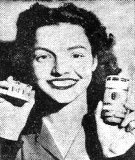 A war-time invention, the "electronic printing" of radio circuits, has been disclosed recently. Here Patricia Brill
holds a printed circuit in her left hand and a variable timing fuse in her right.
A war-time invention, the "electronic printing" of radio circuits, has been disclosed recently. Here Patricia Brill
holds a printed circuit in her left hand and a variable timing fuse in her right.
|
The Kanchrapara crews and the 235th Ammo Co. at Kharagpur were the last to dispose of their stocks. Other dumps included those in the Eastern Bengal towns of Tezgaon, Kurmitola and Shamshernag, and the West Bengal dump for Chemical Warfare shells at Ondal.
TASK FORCE SYSTEM
Not only was a minimum of GI personnel used throughout the program, but ordnance officials paid much attention to keeping up morale and efficiency in the tricky operations. Perhaps the most unusual method was the "Task Force" system at several of the depots, notably Kanchrapara, where a civilian-like incentive program gave each crew of men a specific assignment for the day and threw out the time-old Army custom of looking busy at the job whether or not there was work to do.
The GI crews were fully responsible for the Indian "employees" under them and when their crew assignment had been completed they were through for the day. Work sheets were posted to keep the men fully informed as to what had been accomplished and what remained to be done.
The vast majority of ordnance personnel involved in ammo disposition were Negro troops and it was directly due to them that the ammo disposition became so successful a mission.
And so what some thought might be 25 years of flirting with the Devil, turned out to be only five months of safe and efficient disposition of the Atomic Bomb's badly-licked competitors. Now only the fish in the Bay of Bengal have to contend with some 160,000,000 unexploded pounds of the blame stuff.
 These sleepy shutterbugs in line at the door of the PX in Calcutta are (left to right) T/4 John Murphy, T/5 Harry
Baskin and T/Sgt. Charles Mayer, all of Base Section Hdqs. Co.
These sleepy shutterbugs in line at the door of the PX in Calcutta are (left to right) T/4 John Murphy, T/5 Harry
Baskin and T/Sgt. Charles Mayer, all of Base Section Hdqs. Co.
|
|
GI's Do It The Hard Way CALCUTTA - When the PX in the Hindustan Building announced it would put 35mm cameras on sale recently, T/4 John Murphy, Headquarters Company, must have wanted one real badly. In order to make sure he'd get the camera, Murphy posted himself in front of the PX door at 5:30 p.m. the night before the sale and slept there all night in order to be first in line the following morning. The second camera bug showed up only ten minutes later and several more at about 6:30 p.m. that night. MP's woke them up in the middle of the night to see what was cookin. They finally agreed, "It's OK, we guess, if you want to be suckers." Some sympathetic characters from the Central Medical Dispensary brought around coffee and doughnuts. Murphy, after getting the camera, still thought it was worth the wait. |
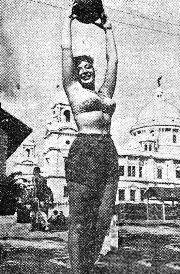
|
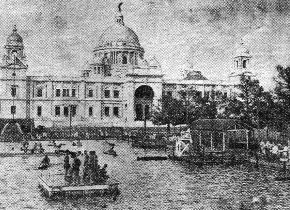
|
| (Left) Elinore Grant, American Red Cross, provides interesting scenery. (Above) General view of the pool. (Below left) Pfc. Clayton E. Keith, T/4 Charles W. Wilke and Pfc. Ernest F. Nash of the 287th Port Co. lunch with ARC's stage star, Anne Miller. (Below right) Fickle? Anne sips refreshment with Sgt. Howard Cantor of the 40th Special Service Co. |
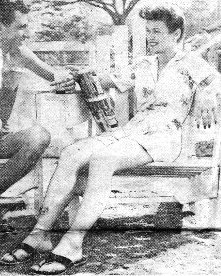
|

|
Returnees Find Swimming Pool Popular Spot
Love being a scarce item in a GI's life, in the spring his fancy has to turn mostly toward the Ole Swimmin' Hole. With the breath of hot weather already in the air, Victoria Memorial Swimming Pool in Calcutta is the favorite spot for men sweating out their ship.
Once just a lily-pond, the Pool was built for the American Army by the British as part of the reverse lend-lease program. The Swimmin' Hole officially opened last year on July 3. Since then 104,381 GI's have passed through its gates.
Base Section Special Services, which operates the pool, is particularly proud of the health record. No cases of disease have ever been attributed to the pool. To make this record possible, 1,000,000 gallons of water - aerated, filtered and chlorinated - flow through the pool every 24 hours. Weekly bacteria tests have proved the water is pure enough to drink. Chlorine content tests are taken every two hours.
The tricky rafts on which GI's knock themselves out were originally secret OSS equipment, intended for use by raiders scheduled to precede amphibious invasions.
The Roundup is a weekly newspaper of the United States Forces, published by and for the men in Burma and India, from news and pictures supplied by staff members, soldier correspondents, Army News Service, and United Press. The Roundup is published Thursday of each week and is printed by The Statesman in New Delhi and Calcutta, India. Editorial matter should be sent directly to Major Floyd Walter, Hq., U.S.F., I.B.T., APO 885, New York, N.Y., and should arrive not later than Saturday in order to make that week's issue. Pictures must arrive by Friday and must be negatives or enlargements. Stories should contain full name and organization of sender. Complaints about circulation should be sent directly to Capt. Drexel Nixon, Base Section, APO 465, New York, N.Y. Units on the mailing list should make notification of any major change in personnel strength or any change of APO.
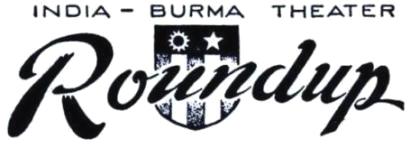
MARCH 14, 1946
Original issue of Roundup shared by CBI veteran Jay Anderson
Copyright © 2006 Carl Warren Weidenburner
TOP OF PAGE PRINT THIS PAGE ABOUT THIS PAGE SEND COMMENTS
PREVIOUS ISSUE CLOSE THIS WINDOW NEXT ISSUE
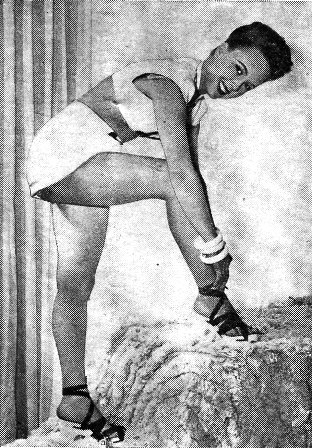 This white swim outfit modeled by shapely Beverly Thomson, was created to be worn by Betty Hutton in a forthcoming
picture. But we ask you, would you call Beverly a substitute? Any of you gentlemen want to help her fix that shoe?
This white swim outfit modeled by shapely Beverly Thomson, was created to be worn by Betty Hutton in a forthcoming
picture. But we ask you, would you call Beverly a substitute? Any of you gentlemen want to help her fix that shoe?